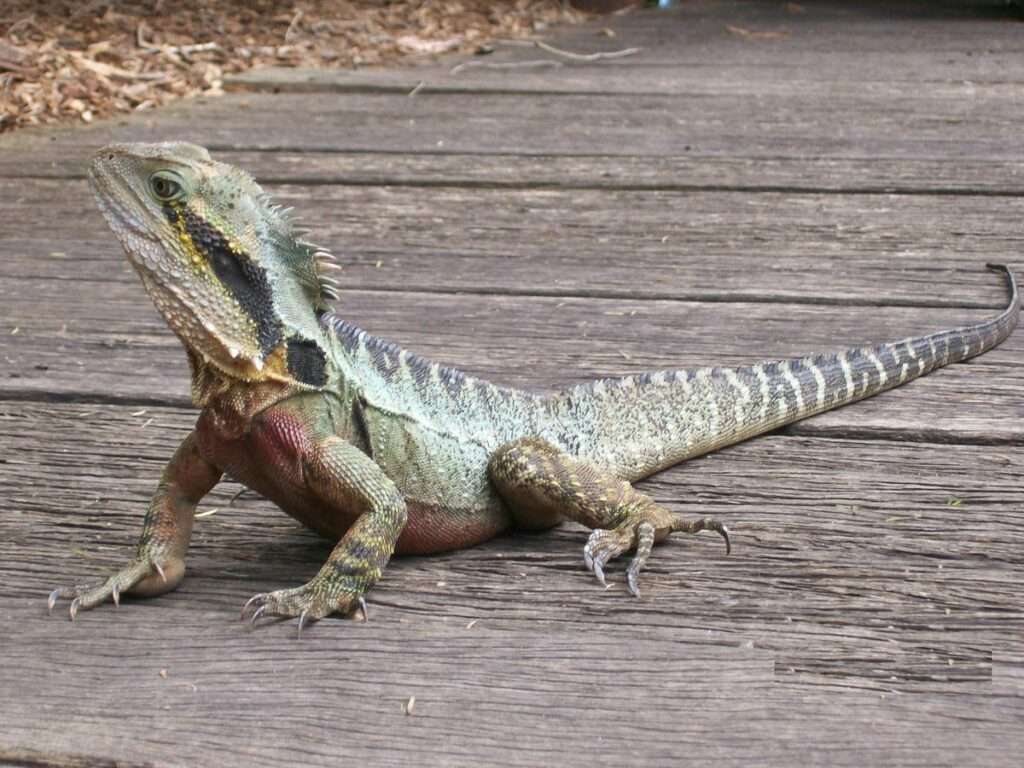
Description:
Scientific name: Intellagama lesueurii
Life span: 10-20 years
The eastern water dragon (Intellagama lesueurii lesueurii) and the Gippsland water dragon (Intellagama lesueurii howittii) are two subspecies of the Australian water dragon (Intellagama lesueurii).
They have protruding nuchal and vertebral crests, long, robust arms and claws for climbing, and a long, muscular, laterally compressed tail for swimming. Males have bigger heads than females and exhibit bolder coloring. The Eastern water dragon and the Intellagama Gippsland water dragon are the two subspecies. Gippsland water dragons lack the dark band behind their eyes and instead have dark bands on either side of its throat, which is blotched with yellow, orange, or blue. Eastern water dragons often have a white, yellow, and red throat and a dark band behind each eye. Both subspecies are predominantly pale greenish grey with black bands adorning their backs, tails, and legs. Water dragons may gradually alter their skin tone to help them blend in, and they lose skin when they are growing.
Native Region/Habitat
From Victoria in the north to Queensland in the east, Australian water dragons can be found. On South Australia’s southeast coast, there might be a small introduced population. They reside near water bodies like creeks, rivers, lakes, and other bodies of water that have places to sunbathe like overhanging branches or rocks in direct or filtered sunlight.

Behavior:
They hide in dense undergrowth or dive into water from an overhanging branch when confronted by a potential predator. To avoid being discovered, they can swim completely submerged and hide for up to 90 minutes on the bottom of shallow creeks or lakes. In the winter, water dragons that live in Australia’s colder climate brumate (hibernate). On or close to riverbanks, they brumate in tunnels between boulders and logs. Australian water dragons use a range of dominant and submissive signs, including head bobbing and arm waving, to communicate with one another.
Slow arm waving denotes submission, while fast arm waving denotes authority. Australian water dragons are sociable creatures that congregate in packs in habitat-appropriate regions. These groupings often include a dominant man, a few females, and young children. Males are territorial and show aggression against other males by posturing, pursuing, and fighting in regions with higher population densities. Australian water dragons are capable of being active both at night and during the day. They are frequently observed in the early hours of the day sunbathing on rocks and riverbanks, taking naps in trees, swimming, and hunting for food. Despite their natural shyness, they can adapt to ongoing human presence in gardens and parks in suburbs. These lizards are adept climbers and quick runners.
Care As a pet/In captivity:
Tank:
The tank itself should be at least 48 inches long by 24 inches wide, but if you can add more space, your water dragon will have a better quality of life. A wooden enclosure is ideal because it allows you to regulate humidity levels, a temperature gradient, and a clear front and solid sides and rear for privacy. There are glass enclosures available, but these will need more attention to provide the optimal environment for your lizard.
Heating (Temperature & Humidity):
You must distribute heat in the enclosure in a gradient. Employ a basking lamp to create a basking area that is roughly 105°F in temperature at one end, then check the temperature at the other end to make sure it is about 80°F at the cooler end. A 70% humidity level is possible. Although while the water dragon can tolerate levels as low as 40%, greater levels cause them to shed more neatly. To make sure you keep an eye on the present humidity levels, mist your plants frequently and use a hygrometer.
Feeding:
From the age of three years, you can cut back to three feedings each week for your young water dragon. The species is omnivorous, meaning it will consume both meat and plants. Although they would consume mice and fish in the wild, they are typically good eaters, so this is not necessary in captivity. Feed locusts as well as black or brown crickets, and make sure they are gut loaded before feeding. Give mealworms or wax worms as a snack.
Table





